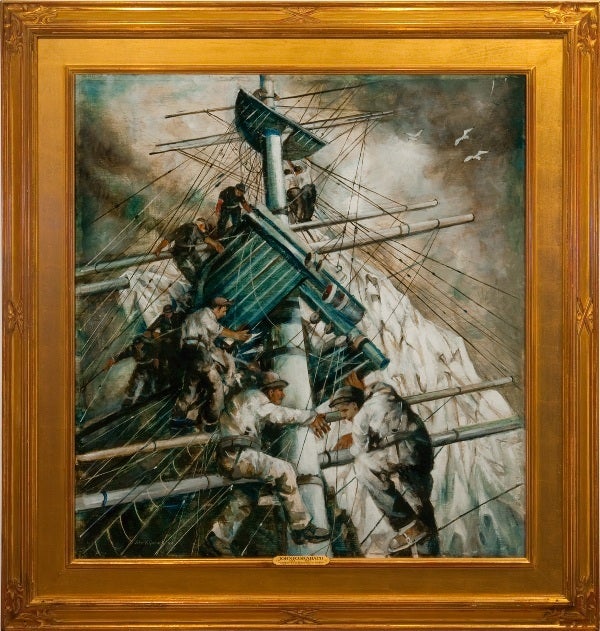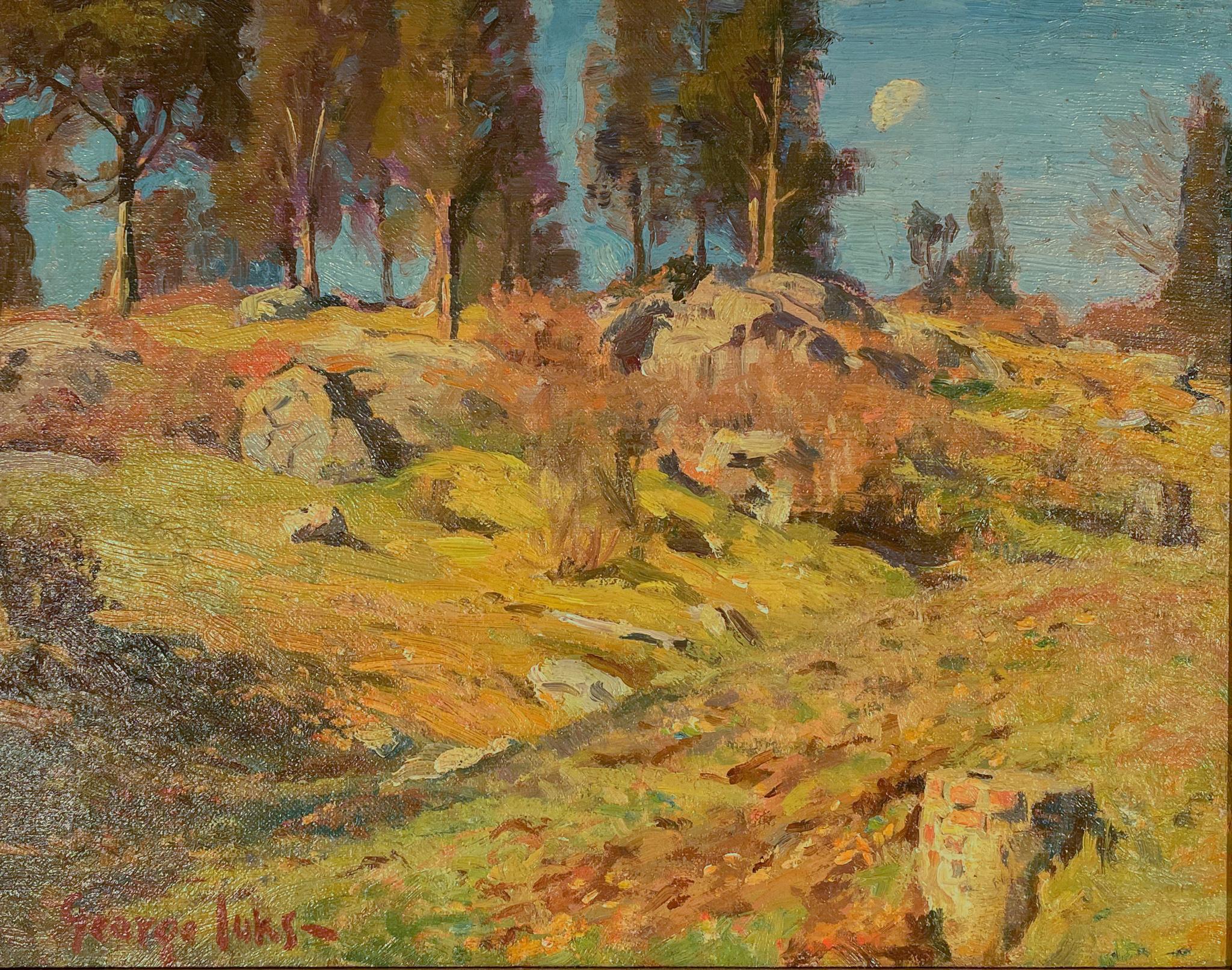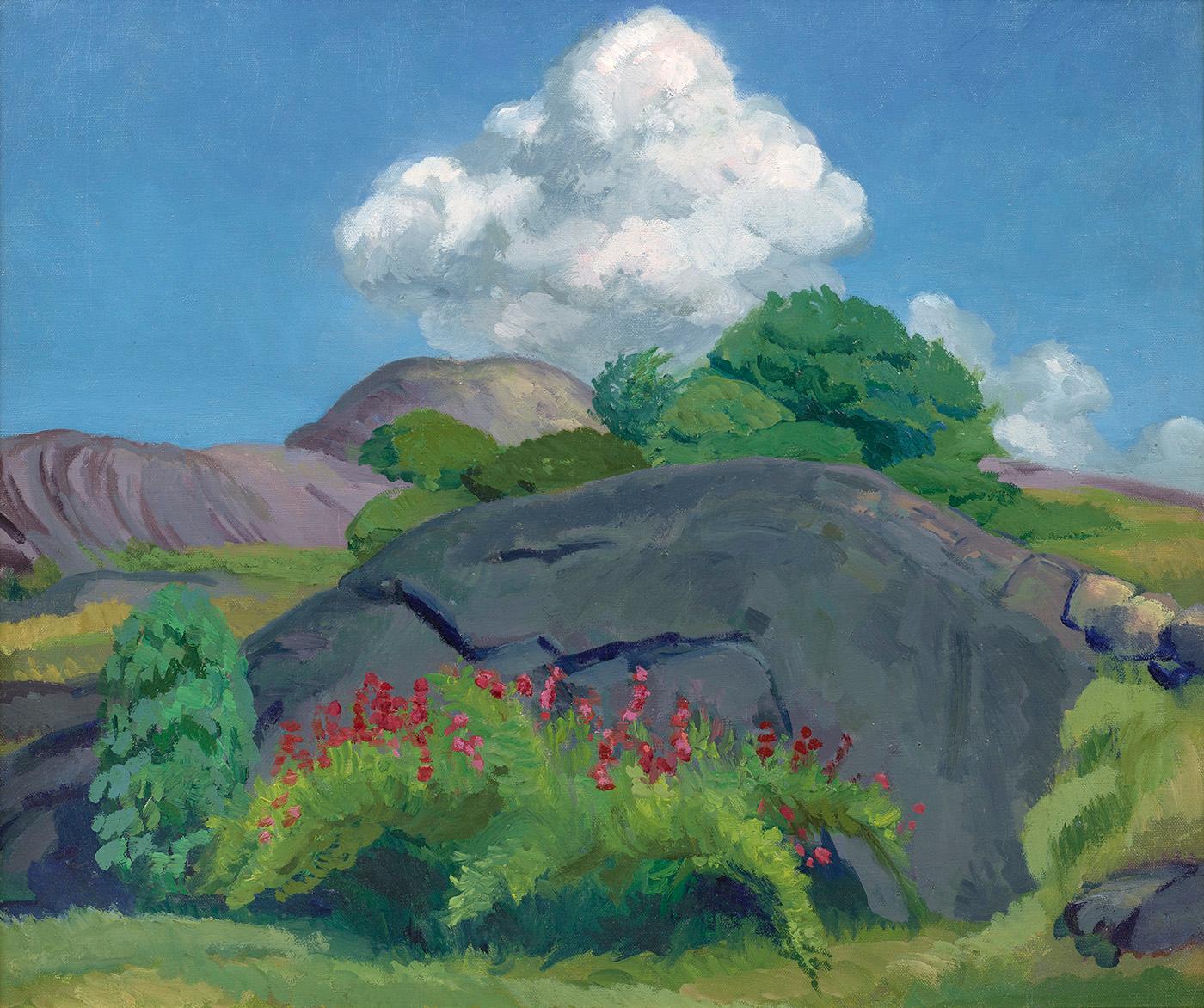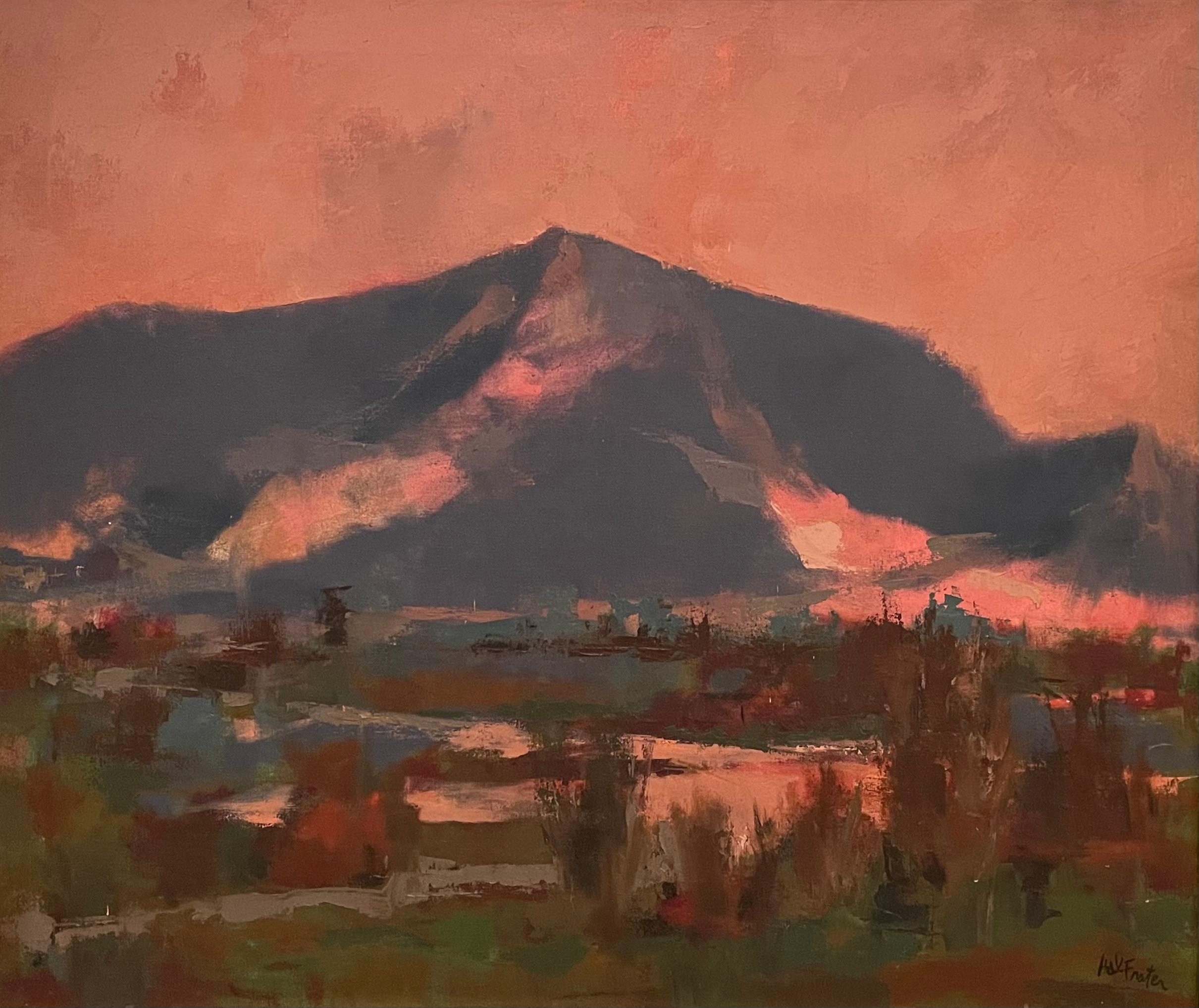Items Similar to Revolutionary Guard House for General Putnam's Army, West Redding, Connecticut
Want more images or videos?
Request additional images or videos from the seller
1 of 9
Leon KrollRevolutionary Guard House for General Putnam's Army, West Redding, Connecticut1911
1911
About the Item
Leon Kroll
Revolutionary Guard House for General Putnam's Army, West Redding, Connecticut, 1911
Signed and dated lower right
Oil on panel
8 1/2 x 10 3/4 inches
Provenance:
Private Collection
(with) Lois Wagner Fine Art, New York
Exhibited:
Ogunquit, Maine, Ogunquit Museum of American Art, The Art of Leon Kroll, July 1 - August 13, 2002.
Leon Kroll was born in New York City in 1884. He studied art at both the National Academy of Design and the Art Students League. Kroll received a scholarship to study at the Byrdcliffe art colony in Woodstock the summer of 1906 and a National Academy scholarship to study in Europe in 1908. Kroll used the scholarship to travel to Belgium, Holland, and Germany the summer of 1908 before settling in Paris in the fall to study at the Académie Julian with Jean-Paul Laurens. Returning to New York in the fall of 1910, Kroll received his first one-man exhibition at the National Academy with 85 paintings.
Upon his return to New York, Kroll met George Bellows and was introduced to Robert Henri, John Sloan, and their post-Eight circle. Kroll was the only young artist of the group who had not studied with Henri and his National Academy training was considered anathema to the Eight’s founding, yet he was embraced by the group and featured in their exhibitions. Kroll’s popularity as an artist grew and his lush brushwork, exciting compositions, and Fauve palette gained him the opportunity to exhibit at the famous 1913 Armory Show, at which he sold all of his paintings.
Leon Kroll and George Bellows painted together on Monhegan Island in Maine in 1913 and returned to the Maine coast the summers of 1915 and 1916. Kroll was invited to Colorado to paint five portraits of the Travis family in 1917. While there, Kroll painted at least ten hours a day, using any spare time from the portraits as a chance to paint the surrounding Rocky Mountains. Already out west, Kroll joined George Bellows and Robert Henri in Santa Fe, New Mexico to paint the local scenery the summer of 1917. During the Teens, Kroll was fascinated by Cézanne and broke up his realist compositions into more geometrical forms.
In 1920 Kroll returned to Woodstock for the summer at the suggestion of George Bellows. In Kroll’s autobiography A Spoken Memoir he recalls frequently hosting fellow Woodstockers the Bellowses and the Speichers for dinners, as well as Robert Henri when he came up to teach at the Art Students League summer program. Kroll spent the summers of 1921 and 1924 in Woodstock as well. From 1925 to 1929 Kroll spent much of his time in France as his new wife was from Paris. Kroll was a leading artist of the 1920s. His still-life and figurative subjects, as well as scenes of New York City, were regularly exhibited both at his New York dealer Rehn Gallery and museum invitationals. He had a large one-man exhibition of 31 paintings at the Art Institute of Chicago in December 1924-January 1925 alongside George Bellows who exhibited 22 paintings.
In the 1930s, Kroll executed some of his best landscape and figurative works over summers in Cape Ann, Massachusetts. He often stretched the season, staying late into the fall to continue his painting. The Carnegie Institute gave Kroll a retrospective in 1935 and the Worcester Art Museum had a solo exhibition in 1937.
In 1938 Kroll sought the quiet of a studio in Bearsville to work on the design for an extensive mural on the First World War for the War Memorial Building in Worcester, Massachusetts. Kroll and his family then lived in Worcester from 1939 to 1941 for Kroll to execute the murals. The largest panel in the series was 30 x 57 feet. Kroll also created murals for the Department of Justice in Washington, DC (1935); the State Capitol of Indiana (1951); and the Omaha Beach War Memorial in France (1952).
Kroll received many awards throughout his career, including early recognition at the Art Institute of Chicago with its purchase prize, the Logan Prize, in 1919 and at the National Academy of Design with the Thomas E. Clark Prize in 1921. He went on to receive further prizes at the National Academy and the Art Institute of Chicago in the 1920s followed by a gold medal at the Pennsylvania Academy of the Fine Arts, first prize in the American section of the Pan-American Exposition in Baltimore in 1931, and first prize at the Carnegie International in 1936.
His memberships included the American Academy of Arts and Letters, Boston Art Club, National Academy of Design, National Arts Club, National Institute of Arts and Letters, New Society of Artists, New Society of Etchers, New York Society of Etchers, Philadelphia Art Club, Salmagundi Club, and the Society of Independent Artists. Kroll’s work can be seen in the permanent collections of the Art Institute of Chicago, IL; Baltimore Museum of Art, MD; Corcoran Gallery of Art, Washington, DC; Dayton Art Institute, OH; Indianapolis Museum of Art, IN; Los Angeles County Museum, CA; Metropolitan Museum of Art, NY; Pennsylvania Academy of the Fine Arts, PA; and the Whitney Museum of American Art, NY.
- Creator:Leon Kroll (1884-1975, American)
- Creation Year:1911
- Dimensions:Height: 12 in (30.48 cm)Width: 14 in (35.56 cm)
- Medium:
- Movement & Style:
- Period:
- Condition:
- Gallery Location:New York, NY
- Reference Number:1stDibs: LU1841213195642
About the Seller
5.0
Platinum Seller
These expertly vetted sellers are 1stDibs' most experienced sellers and are rated highest by our customers.
Established in 2021
1stDibs seller since 2022
60 sales on 1stDibs
Typical response time: 1 hour
- ShippingRetrieving quote...Ships From: New York, NY
- Return PolicyA return for this item may be initiated within 3 days of delivery.
More From This SellerView All
- "Portland Harbor, Maine, " Alexander Bower, Snowy River Scene in WinterBy Alexander BowerLocated in New York, NYAlexander Bower (1875 - 1952) Portland Harbor, Maine, 1910 Oil on canvas 27 x 33 inches Signed and dated lower right An American Impressionist, Alexande Bower was born in New York, studied at The Pennsylvania Academy of Fine Art, and was living with his wife in Cliff Island, Maine by 1914. Despite his urban upbringing, the coast and the sea fascinated Bower. A large portion of his paintings are seascapes, particularly scenes depicting the coast of Cape Elizabeth...Category
1910s Ashcan School Landscape Paintings
MaterialsCanvas, Oil
- "Summer Landscape, " Joseph DeCamp, Boston Ten American ImpressionistsBy Joseph Rodefer DeCampLocated in New York, NYJoseph Rodefer DeCamp (1858 - 1923) Summer Landscape Oil on board 11 x 15 inches Signed lower right Born in Cincinnati, Ohio on November 5, 1858, Joseph DeCamp began his artistic career in his teens and remained active throughout his life. Although he initially painted landscapes, Decamp became a renowned and respected portraitist. He was famous for his images of men of high society and women within domestic interiors. Decamp began his artistic training in 1873 when he enrolled in the McMicken School of Art and Design in Cincinnati. The head of the school, Thomas Satterwhite Noble, was a European-trained painter whose "insistence on rigorous draftsmanship, true to the academic manner in which he had been trained, exerted a lasting influence on DeCamp." DeCamp studied under Noble for five years, but was also a student of Frank Duveneck at the Ohio Mechanics Institute. He adopted Duveneck's bold, realistic style and many of his paintings executed throughout the 1870s and 1880s reflect this influence. Like most American artists of his generation, DeCamp went abroad to study. In 1878, following in the footsteps of Duveneck and other Midwesterners, he traveled to Munich to attend the Royal Bavarian Academy. Soon after his arrival, however, he gravitated away from the academy and towards Duveneck and eventually followed his mentor to Florence and Venice. During these years, DeCamp focused on landscape and portraiture as his primary subjects. These themes would continue to occupy the artist when he returned to America in 1883. When DeCamp arrived back in the United States in 1883, he first settled in Cincinnati, but soon moved to Cleveland to teach at what is now Case Western Reserve University. He then relocated once more to the Boston area, where he would remain for most of his life. DeCamp began teaching at Wellesley Female Academy and, in the fall of 1885, began as an instructor at the School of Drawing and Painting at the Museum of Fine Arts in Boston. He quickly established himself as one of the leading figures in the Boston art community and became a founding member of The Ten American Painters, formulated in 1897. This group included Childe Hassam, John Henry Twachtman, Julian Alden Weir, Frank Benson, Thomas Dewing, Willard Metcalf, Robert Reid, Edward Simmons...Category
19th Century American Impressionist Landscape Paintings
MaterialsPanel, Oil
- Saratoga Springs Racetrack, Summer Grandstand Crowd, Horse BettorsBy Anne DiggoryLocated in New York, NYAnne Diggory (b. 1951) Grandstand Crowd, Saratoga Springs Racecourse, New York Oil on panel 26 x 31 inches Initialed lower right: APD Anne Diggory lives ...Category
1970s Contemporary Figurative Paintings
MaterialsOil, Panel
- "Young Beauty Crossing Brook with Hunter, " Emile Pierre Metzmacher French SalonLocated in New York, NYÉmile-Pierre Metzmacher (French, 1815 - 1890) A Young Beauty Crossing a Brook, A Hunter Beyond Oil on panel 24 x 19 1/2 inches Signed lower left Provenance: Christie's New York, Oct...Category
Mid-19th Century Figurative Paintings
MaterialsOil, Wood Panel
- "Concarneau, Brittany, France" Hayley Lever, American ImpressionismBy Hayley LeverLocated in New York, NYHayley Lever (1876 - 1958) Concarneau, Brittany, France, 1905 Oil on panel 6 3/4 x 9 1/2 inches Signed by the artist lower left Inscribed by another hand on the reverse Provenance: Clayton-Liberatore Galleries, Bridgehampton, New York Hayley Lever’s (1875-1958) versatility has worked against his posthumous reputation. He was never associated with a single artistic movement, instead producing impressionist, post-impressionist, and expressionist works. While best known as a painter of post-impressionist marine scenes, his subject matter included landscapes, urban scenes, and still lifes across his 60-year career. This lack of a singular style or subject has given him an amorphous place in U.S. art history despite his obvious accomplishments. [Richard] Hayley Lever was born in Bowden, South Australia in 1875. He excelled in painting classes at Prince Alfred College (1883-91) and Norwood Art School (1891-93) in Adelaide. In the 1890s, Lever moved to England, studying art in London and painting at St. Ives, a fishing port and popular artistic colony on the Cornish coast. In St. Ives, Lever shared a studio with Frederick Waugh, and studied painting with Albert Julius Olsson and Algernon Talmage. Lever was a plein air painter particularly interested in the effect of sunlight on the sea. He painted in a distinctive style, strongly influenced by the works of Vincent van Gogh, that might now be called post-impressionism. He used a limited palette to paint the St. Ives harbor, particularly at dusk or in the moonlight. His strong contrasting colors and thick use of paint created a crisp and physical surface that earned him acclaim in Europe. Lever’s many St. Ives seascapes are among his most popular works. In 2017, his painting entitled “The Old Lighthouse and Fleets of St. Ives” sold at auction for $162,500. In 1912, Lever moved to New York to test the art market in the United States. In Manhattan, Lever met prominent U.S. painters such as Ernest Lawson, Robert Henri, William Glackens, John Sloan, and George Bellows. Lever exhibited with this group regularly in New York City, painting parks, streets, bridges and the Manhattan waterfront. However, he soon discovered the scenic potential of Gloucester, Rockport, and Marblehead in the Cape Ann area of Massachusetts...Category
Early 1900s American Impressionist Landscape Paintings
MaterialsOil, Panel
- "On the Beach, " Nicolai Cikovsky, American Impressionism, Landscape SeascapeBy Nicolai CikovskyLocated in New York, NYNicolai S. Cikovsky (1894 - 1984) On the Beach Oil on panel 15 1/4 x 20 inches Signed lower right Provenance: ACA Galleries, New YorkCategory
Mid-20th Century American Impressionist Landscape Paintings
MaterialsOil, Panel
You May Also Like
- "After the Storm"By John R. GrabachLocated in Lambertville, NJSigned LL John Grabach was a highly regarded New Jersey artist, teacher and author of a classic text, How to Draw the Human Figure. He was born in Massachusetts, and with his widow...Category
20th Century Ashcan School Figurative Paintings
MaterialsOil, Panel
- Forest LandscapeBy George LuksLocated in New York, NYLandscape by George Luks (1867-1933) Oil on canvas 11 x 14 inches unframed (27.94 x 35.56 cm) Signed lower left Description: George Luks was an American artist originally born in Pe...Category
20th Century Ashcan School Landscape Paintings
MaterialsOil
- White Cloud and RockBy John SloanLocated in New York, NYKnown as the “dean of American artists,” John Sloan was one of the most influential members of the Ashcan school.Category
1910s Ashcan School Landscape Paintings
MaterialsOil
- Under the HollowBy Alexander Oscar LevyLocated in Buffalo, NYAn important American modern landscape by Ashcan school artist Alexander O. Levy. This painting was featured in the retrospective for the artist held at the Burchfield Penney Art Ce...Category
1930s Ashcan School Landscape Paintings
MaterialsCanvas, Oil
- 'Pink Sky' by Hal Frater - Mountain Range at Dusk - Oil Painting on CanvasBy Hal FraterLocated in Carmel, CAHal Frater's "Pink Sky" is a moody landscape that masterfully captures the play of light at dusk. Dominated by a majestic mountain under a vast, dusky sky, the painting is steeped in...Category
1970s Ashcan School Landscape Paintings
MaterialsCanvas, Oil
- New York scene done by John Grabach Artist "Trinity Church - Wall Street"Located in Rockport, MAGreat Wall Street piece by John R. Grabach (March 2, 1886 – March 17, 1981) with expressive colors and figures. Grabach was a renowned American painter, best known for his evocative...Category
1920s Ashcan School Figurative Paintings
MaterialsOil
Recently Viewed
View AllMore Ways To Browse
Robert Indiana Eight
Colorado Fauve Landscape
Farm House Art
Gas Light Los Angeles
Be Prompt To Class
Nagoya Chair
Red Sailboat Painting
Vision Of Gala
Unicorn Oil Painting
Tall Antique Oil Painting
Provencal Village Painting
Red Parasol
Halle Bros
Pueblo Christmas
Nicola L Eye Light
Pennsylvania Sellers
Waterlily Oil Painting
Robert Redbird



